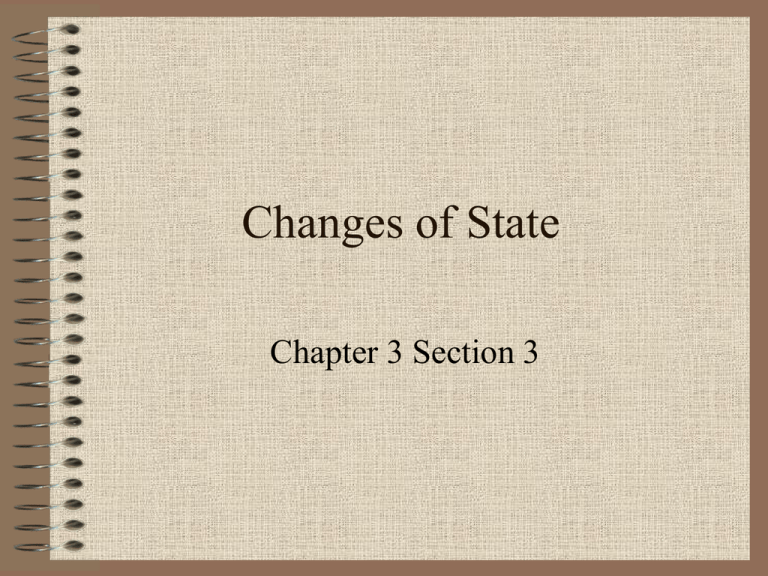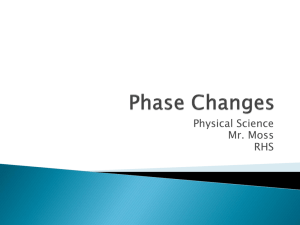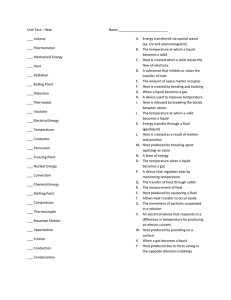Changes of State - Red Hook Central School District
advertisement

Changes of State Chapter 3 Section 3 Energy & Change of State • The change of a substance from one physical form to another is a change of state or phase. • Remember, in a physical change the identity of the substance does not change, only it’s physical form. • Ice, liquid water, and steam are all made of the same molecules. • These substances are different only in the arrangement and motion of the molecules. Movement of Particles • In different states, or phases, the molecules move differently because they have different amounts of energy. • To change a substance from one state of matter to another you must add or remove energy. • The five phase changes are melting, freezing, condensation, vaporization, and sublimation. Melting • When heat is added to a substance to cause it to go from a solid to a liquid, melting has occurred. • Adding energy increases the temperature of the solid, causing the molecules to move faster. • Melting will occur when a certain temperature has been reached, the melting point. Melting • Look at figure 2 page 75. Why wouldn’t gallium, a metal element, be useful as jewelry? • Gallium melts at 30°C. Normal human body temperature is 37°C, so gallium will melt in your hand. • Melting occurs when molecules move fast enough to overcome their attractions to each other. • Melting is endothermic because energy is added. Freezing • When heat is removed from a substance and it changes from a liquid to a solid, freezing has occurred. • The temperature at which a liquid changes to a solid is the freezing point. • Freezing and melting will occur at the same temperature. Freezing • Look at figure 3 page 75. At a certain temperature, what will determine whether water will melt or freeze? • The addition or removal of energy. • For a liquid to freeze the attractions between the molecules most overcome their motion. • Removing energy will cause molecules to lock into place. • This is exothermic because energy is removed. Vaporization • A term not used in your textbook is vaporization. • This is the phase change from liquid to gas. • There are two types of vaporization: – Evaporation – Boiling • Vaporization requires the addition of heat, so it is endothermic. Evaporation • When liquid changes to a gas at temperatures below the boiling point, evaporation has occurred. • Evaporation occurs at the surface of the liquid. • Sweating helps cool your body because the water evaporates from your skin, taking the heat with it. Boiling • When liquid changes to a gas throughout the liquid, not just at the surface, boiling is taking place. • The temperature at which a substance boils is the boiling point. • Pressure will effect the boiling point of a liquid. When pressure is less, so is the b.p. Condensation • The change of state from a gas to a liquid is condensation. • The condensation point is the temperature at which the gas becomes a liquid and is the same as the boiling point of the substance (at a given pressure). • Energy must be removed for condensation to occur, so it is exothermic. Sublimation • The change of state from a gas to a solid or a solid to a gas (where the liquid phase is bypassed) is sublimation. • Sublimation can be endothermic or exothermic. • Dry ice, iodine crystals, and ice can all sublime. Change of Temp vs. Change of State • When most substances lose or gain energy, one of two things will happen to the substance (not both): – The substance will change temperature OR – The substance will change state Change of Temp vs. Change of State • When temperature changes, the speed of the molecules changes. • Temperature cannot change until the change of state is complete. • The temperature of boiling water stays at 100°C until all of the water has vaporized, no matter how much more heat you add. Figure 7 Page 79 • Look at Figure 7 on page 79. This is a graph of the “Heat Curve” of water. • At what temperature does water melt? • At what temperature does water boil? • Does the temperature change when the water is changing states? • Why? Why not? Additional Questions • Why is antifreeze added to automobile engines during the summer as well as the winter? • What is the purpose of adding salt to boiling water when making pasta, and putting salt on icy roadways in the winter? • Answer these questions by referring to melting and boiling points.






